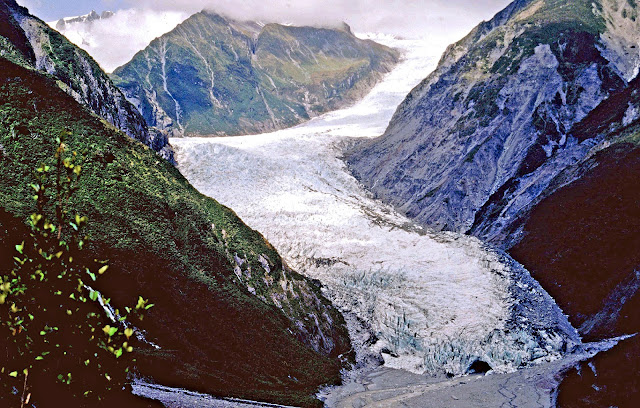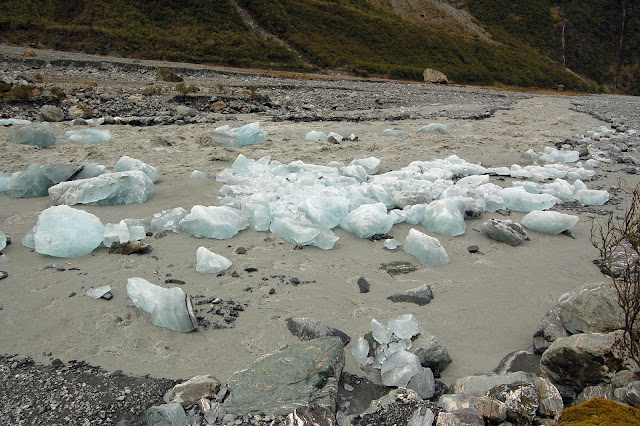 |
| Canoeists passing Tamatea's Cave on the Whanganui River |
Now listed as one of New Zealand's Great Walk, the Whanganui River is actually a great canoeing experience. The River, New Zealand's 3rd longest, now has the status, with the rights, duties and liabilities, of a legal person, reflecting the importance of the river to the Maori people.
In the 1990s and early 2000s, we included a 4-night. 5-day canoeing experience in our New Zealand tours. The canoeing began in the small riverside settlement of Whakahoro, where the Retaruke River meets the mighty Whanganui, and finished in the larger (not much), settlement of Pipiriki on what is known as the River Road. This river trip was delightful on fine, sunny days but, of course, could be pretty miserable when it rained. Campsites were basic, but had long-drop toilets and a DOC (Department of Conservation) erected shelter, under which we could cook, with a hand basin and a rain-water tank. The Whanganui was regarded as a novices' river and a wilderness experience.
This photo essay is compiled of photos I have taken over the years.
First of all the canoes had to be carefully packed. Personal equipment, sleeping bags, cameras, food etc. were stored in waterproof barrels, hopefully with a water-tight latch - if secured properly!
Once the canoeists have gained confidence, there is time to relax in the sun in the more benign stretches of the river.
After a couple of hours paddling it is time to stop for a refreshment and a leg stretch on one of the many shingle banks on the River.
The first night's camping at Ohauora was always something of an experience. For many of our clients this was their first taste of real wilderness camping, and a camp fire from the river driftwood was always popular.
The 'long-drop throne room' was again something that many of our clients had not experienced before. This original 'architectural gem' was situated in a sylvan setting at Ohauora & when you heard someone approaching, you would surreptitiously cough. DOC upgraded this edifice in later years.
Some of the formations on the Whanganui has some rather interesting and innovative names. This was Man o' War Bluff, as it bore a resemblance to an early iron-clad battleship. The bow slopes down to the water, just to the right of the red canoe, and a hawsehole can be seen directly above the canoe.
Another interesting feature of the River was the feature known as the Drop Scene. Here the the river disappears around an obscured bend behind the canoes. As one approaches this bend the scenery appears to move, like the 'Drop Scene' of an old vaudeville theatre. It was also the scene of a Maori tribal battle in the early 19th century.
The Mangapurua Landing had originally been developed as road access to the Mangapurua Farm Settlement, developed from 1917 for World War One veterans. two or three kilometres from the Whanganui. Groups walk from here to the Bridge to Nowhere.
The Bridge to Nowhere was a road bridge built in the late 1930s to give motor access to the Whanganui River for the farmers of the Mangapurua Farm Settlement. Very few motor vehicles used the bridge, as weather conditions caused road collapses further up the valley, isolating the Bridge. The Farm settlement was eventually abandoned in the early 1940s, and nature was allowed to take over.
On later river trips we stayed a night at the Bridge to Nowhere Lodge at Ramanui. Evenings were particularly restful and beautiful.
I was always fascinated by the natural rock girdle along the river banks, especially when the water was crystal-clear and mirror-like. It was difficult to see where the water actually began.
On the last day, when everyone thought they were accomplished canoeists and complacency had taken over, we had to pass through the Autapu Rapid. If the river level was low, the rapid could be demanding and exciting. Here the author, with a nervous client up front, enters the Rapid.
Some clients had taken notice, and remembered, instructions on how to tackle the Autapu Rapid successfully.
For others, things didn't quite go according to plan, and the Autapu claimed other victim. Fortunately this rapid was short and the bedraggled casualties could haul their upended or swamped canoe ashore on a shingle bank to dry out.
On the lower reaches of the River there were side creeks to investigate such as the Mangaeao River.
As we neared Pipiriki, the River wound through farmland.
Finally, journey's end was reached. The canoes are hauled ashore at the Pipiriki Landing and unloaded for the road journey to Whanganui City.
Text & photographs ©Neil Rawlins
Selected travel photos from these & other blogs are available from my photo gallery |







































